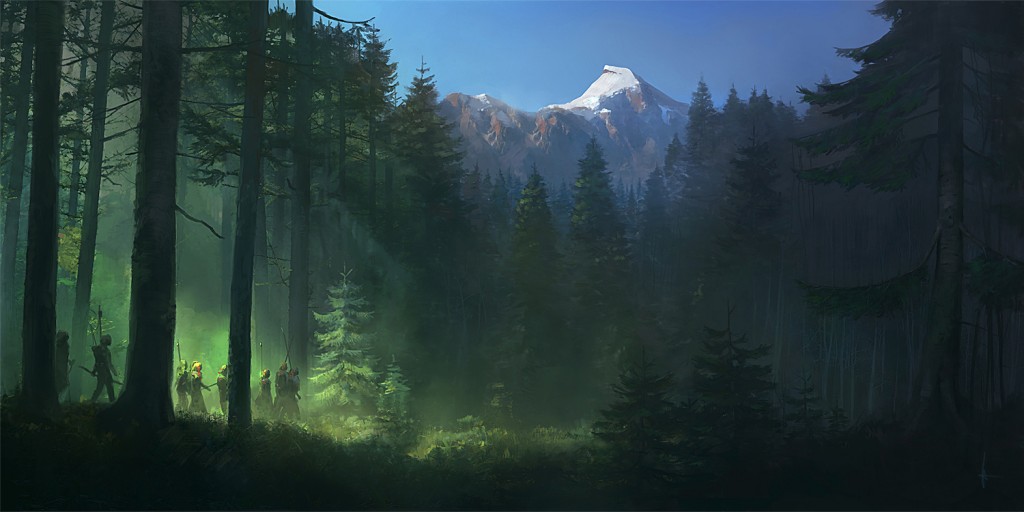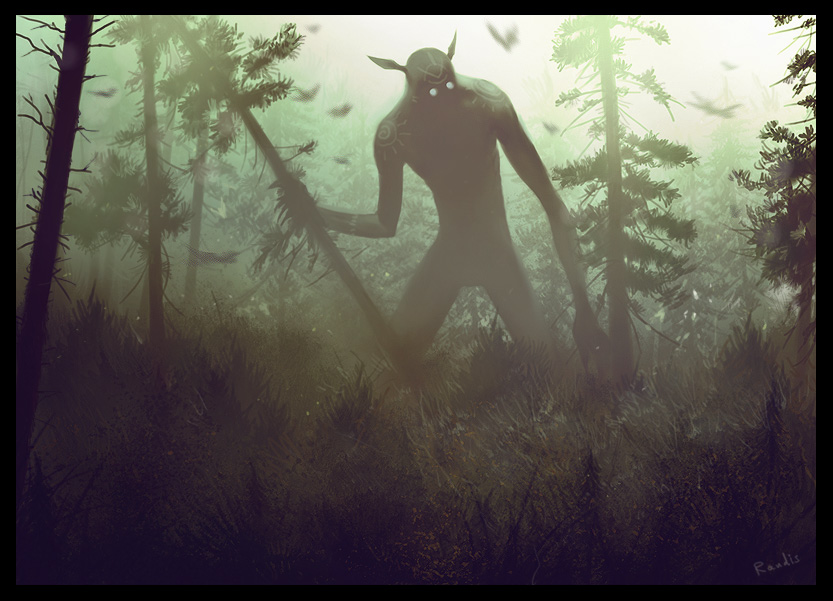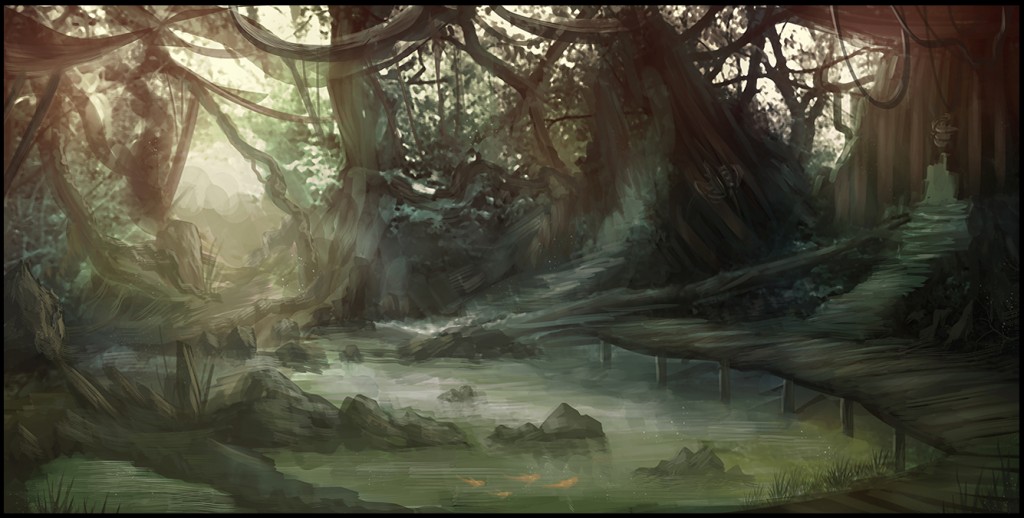The Ancient Lands lie on the eastern coast of a large continent, which runs approximately from North to South for about 2,000 miles. The northernmost parts, bordering the arctic sea, have a cold climate with long winters and don’t see the sun for about two weeks. The very south is covered by huge jungles experiencing heavy monsoon seasons. Most people live close to the coast and no more than a hundred miles from the sea, with civilization reaching farther inland only along the major rivers that run from the highlands and mountains in the west to the sea in the east. With wind predominantly blowing from the east, ships can relatively easily up the rivers for considerable distances. As there are very few roads in the Ancient Lands, almost all trade and long distance travel is done by ship. Only the caravans that bring goods from the human lands on the plains in the west form a major overland trade route. In addition to the major population centers on the coast, there are also thousands of islands of various sizes, of which a countless number is inhabited by elves, lizardmen, or humans, but an even larger number is completely unsettled and unexplored.
The Far North: In the very north of the Ancient Lands, between the arctic sea and a long mountain range that forms a natural border to the lands in the south, lies the little known homeland of the Mari, a small population of tall humans with pale skin and rich brown hair. While most humans in the Ancient Lands are the descendants of nomads who have arrived from the west only in recent centuries, the Mari apparently have inhabited this land forever and neither elves nor kaas have any legends of their first arrival. There are few trees in the Far North and very little grows during the short farming season, so the Mari live mostly from herding reindeer, hunting elks, seals, and whales, and fishing. Few traders make the long trip over the treacherous seas, but thick animal furs and whalebone are quite valuable in many lands to the south. The Far North is home to many strange spirits unlike those found anywhere else in the Ancient Lands, whose motives are very hard to understand even for experienced shamans and witches visiting from other lands.
The Witchfens: South of the mountains that protect the rest of the Ancient Lands from the worst of the arctic winter lies a large highland of fens and bogs known to the people of the surrounding regions as the Witchfens. Very few people ever go there as there is nothing to be found that would be valuable for trade and is home to all manners of dangerous and hostile spirits. Fog and light rain dominate the weather and during the summer it’s a breeding ground for huge swarms of insects. Despite being regarded as one of the most inhospitable places in the Ancient Lands, it has been home to a secluded group of small human tribes known as the Katra, who have arrived there less than a thousand years ago. While they look similar in appearance to the Vandren who have settled in much larger numbers in the south, and share a somewhat similar language, their culture has become entirely different and they regard each other and strangers. These people live in small villages made from uncut stones with earthen roofs and have only very little metal, which they seem to get mostly from raids on neighboring lands. A peculiar trait of their society is that each clan is not ruled by a chief, but instead only has a first warrior who is loyal to an Elder Witch. The witches are almost all female and are the real rulers of this dreadful land. They don’t leave their homeland and do not accompany the warriors on raids and it is most likely that their special relationship to the spiteful spirits of this land is the true reason why their people have settled there.

The Western Forests: In the west of the Witchfens the swamps gradually turn into a forest of pines and firs that are part of the huge woodlands that cover most of the Ancient Lands. These forests, together with the northernmost parts of the great plains that lie beyond the western edges of the woodlands, are the homeland of the kaas. These beastmen are taller and stronger than either humans and elves and can wrestle easily with lizardmen – though it is rare that these two peoples meet – and are equally at home in the forests, the plains, and the barren hills they have inhabited for unknown ages. Sometimes they travel along the coast of the arctic sea in boats to trade with the Mari, but there are no roads that connect their distant homeland with the rest of the Ancient Lands. Mercenaries and explorers often travel south to the lands of the Falden and Vandren along old paths, but most of them are impossible to use with carts. To the other people of the Ancient Lands the kaas are a people of strong warriors hailing from a mystical land and they generally seem not inclined to talk a lot about their culture and traditions. There is also a small stronghold of Eylahen elves in the foothills of the northern mountain range, which overlooks the western end of the Witchfens.
The Barrier Hills: To the south and east of the swampy highlands of the Witchfens lies a long ridge of steep and jagged hills which is one of the two centers of skeyn culture, a race of short people with large black eyes and big ears that live underground. It’s from these hills where the majority of all steel in the Ancient Lands originates. The kings of the skeyn live in massive fortresses high up in the hills, which are like small cities in their own right, but the majority of skeyn lives in smaller villages in the lowlands to the south, at the edges of the Great Forest. The skeyn have very few contact to the people of the Witchfens and their raiders usually avoid the skeyn fortresses. They do however have a lot of trade with the Falden elves that live to the south, as well as with the small clans of the human Vandren that inhabit the northernmost outpost of their people. The skeyn have build a great wealth on the trade with tin, which they are selling throughout all the Ancient Lands, but in the last centuries were able to much improve their situation by selling tools, weapons, and armor made from steel, which is produced barely anywhere else.
The Northern Coast: The long stretch of coast that stretches from the mountains that border the lands of Mari in the north to the Burning Mountains in the south is only sparsely settled. It lies between the sea in the east and the Witchfens and Barrier Hills in the west, and the the steel and tin that comes down the rivers from the hills is the main draw for most merchant ships that come to the small port towns of the local Falden. Only about a century ago, some small clans of humans left the lands settled by the main group of the Vandren migration and traveled farther north to these only thinly inhabited parts. Many of them now live along the rivers that connect the mines in the hills to the ports on the coast, selling their services as mercenaries to the river traders.
The Burning Mountains: While this mountain range is not particularly long or high, it still reaches over two miles in height and is quite steep in many places. It separates the rest of the Ancient Lands from what is usually called the Northlands and though it is possible to go around them by passing through the Great Forest in the west, this is where all the coastal roads end. In addition to being difficult to travel, many of the mountains are also active volcanoes and smoke and other fumes rise from cracks in the ground in many places. There are countless stories of hidden passages that lead all the way down to the Underworld and few people in the Ancient Lands have doubt that this is actually the case. Some of the most terrifying monsters of legend are said to have come down from these mountains and explorers and desperate travelers seeking a shortcut through the mountains have told countless stories about strange creaters beeing seen in this strange land. Despite these stories, the mountains are not particularly hostile to life and there exists dozens of small isolated villages in the more fertile valleys. Most of these mountain folk are elves or humans, but their ancestry is difficult to discern and they are known for their strange customs and the strange spirits they revere. In addition to that, stories of hidden strongholds where elven warlocks practice their dark arts in secret have been around since the earliest cities on the coast blow.
The Northern Islands: To the east and slightly to the north of the Burning Mountains lies a group of islands consisting about a dozen major islands and thousands of small rocks. Two of the larger islands are home to the Neshanen, elves that are closely related to the Falden of the mainland, but are fairly isolated and tend to be regarded as somewhat odd. Despite that, their ships frequently travel between the Northern Coast and the Elven Heartlands and are sometimes even seen in the Far North or the Southern Islands. People who have been to the island describe them as rainy and outright dreadful during the winter and the local elves have all kinds of rituals to the spirits of the winds and the sea unknown in other parts of the world.

The Elven Heartlands: The regions of the Great Forest that lie to the south of the Burning Mountains are the center of wood elf civilization. Two major elven cities have come to dominate the region, which in turn are almost entirely control by two large and powerful orders of druids and sorcerers respectively. While each city and town is ruled independently by its king or chief, the old conflict between these two magical traditions has shaped the history of the region for many centuries. Their support of many of the local chiefs has had a huge impact and shaping the current distribution of power and possession of land and may have made a greater difference than the hiring and eventually settlement of Vandren mercenaries from the human lands to the far west. In addition to the elves, the foothills of the Burning Mountains are also home to one of the two major kingdoms of the skeyn. While the shamans of the skeyn share the reservations of the elven druids against the sorcerers, they usually prefer to stay out of that conflict.
The Grasslands: Between the Great Forest in the north and the Southern Jungles in the south lies a vast open plain of grass and shrubs that divides the Ancient Lands into a northern and a southern half. The plain is devided roughly along the middle by a large river that runs from a spring near the mountain pass that connects the Ancient Lands with the Great Plains in the west, all the way to the coast, which makes it the most important trade route in the known world. All the goods from the west come down this river, and its banks where the site of huge streams of Vandren that came to the Ancient Lands. First mercenaries to support the elven warlords, and later settlers to make a new home on the plain. With them they brought large herds of cattle, previously unknown in the Ancient Lands, but well suited to the Grasslands, which are even better grazing grounds than the ancestral lands of the Vandren. As the elves had never settled in the plains, the elven leaders were perfectly willing to leave them to their new mercenaries, but in recent generations the growing population of humans has started to push into the lands along the forest edge to the north, which is leading to increased numbers of clashes between the two peoples. On the eastern end of the plain, the land drops steeply down into the sea and in some places rises more than a quarter of a mile above the water. Many of these cliffs are full of caves and ancient sinkholes, and one of the largest of these is the site of one of the largest port cities in the Ancient Lands. The river reaches the sea in a wide depression in the cliffs that is covered by a huge swamp.
The Southern Coast: South of the Grasslands the landscape is dominated by a single massive jungle of which even the locals can not say how far inland and south it reaches. The parts of the jungle close to the Grasslands are the homeland of the dark elves. The dark elves don’t mingle nearly as openly with other people as the wood elves to the north, and there are only a few ports directly on the coast, while most of the population lives deeper inside the jungles and keep to themselves. The ports mostly deal in herbs and spices native to the region, but there is also a very active market for both slaves and exotic animals. In addition to other dark elves, the slave traders often capture lizardmen, humans from the southern islands and wild treefolk, a local race of short rat-people.
The Southern Islands: Many miles off the coast lies a very large group of islands, the largest of which are big enough to hold all the lands of a dozen kings from the mainland. There are several small ports visited primarily by pirates from all over the Ancient Lands, but the majority of the native population are lizardmen and a human race called the Amakari. The lizardmen have been living separate from their kin on the mainland for longer than anyone can remember, and have a quite distinctive culture unique to them. The Amakari look very unlike the Vandren or the Ketra of the Witchfens, with dark brown skin and thick brown hair, with the men growing bushy beards. Neither of the two people produces and metal or build large ships, which makes them poorly equiped to deal with raids by pirates or slavers from the mainland.

The Lizard Jungles: All the land that lies south of the homes of the dark elves is refered to as the Lizard Jungles by people from the north. There are few maps of the coast that far south and virtually no confirmed information on any lands lying up the major rivers of this distant region. This part of the world is the home of the lizardmen, who fall into two major group. Most of the jungle is untamed wilderness inhabited by savages and barbarians, going to battle with nothing but stone spear and wooden shields, and the hides of crocodiles and other forest beasts. However best known to people from the north is the empire of the Sun Priests. Over 3,000 years ago shamans worshipping the sun started a rebellion of the lizardmen slaves against their naga overlord, which not only succeeded in driving out their serpentine masters, but also taking control of their capital city itself. For countless generations a king chosen by the priests has ruled over this first true humanoid civilization, but he himself is only a servant of the allmighty sun, that lead the people to freedom. Among the powerful of the city it is well understood that it lies entirely with the priesthood to determine the will of the sun and whether the current king is still in its favor or misusing his divinly appointed office.
